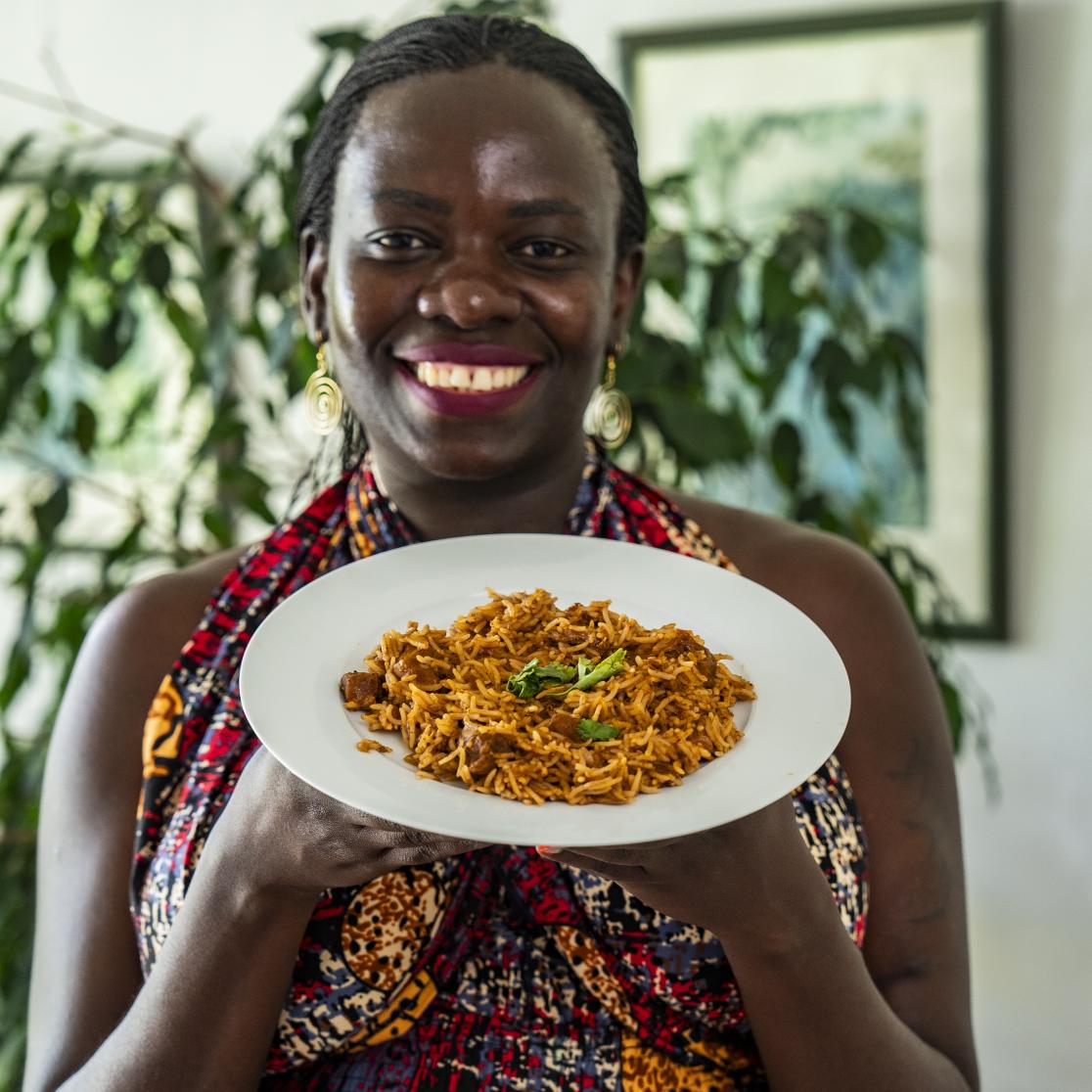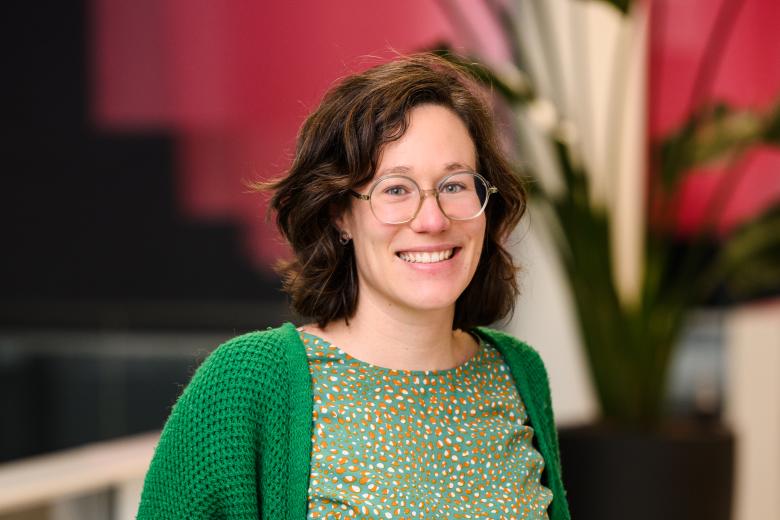Food brings the family closer
Sharon Anyango moved from Kenya to Maastricht six years ago for the Master in Globalisation and Development. At first, things were tough: the education was completely different from what she was used to. So, too, was the food culture—especially lunch. “I still can’t get used to the sandwiches.”
Sharon Anyango grew up in Kisumu, in western Kenya. “Fishing and farming are the main sources of livelihood there. I lived with my mother, two sisters and two brothers in a homestead in a village just outside the city. My father has two wives; my mother is the second wife. We lived next door to each other, but the households are separated. Only at Christmas do we eat and cook together. Kenya has 43 tribes; I come from the Luo tribe. In many tribes, polygamy is common and legal.”
Her mother, with a government job and her own catering company, was the breadwinner. Both Anyango’s parents are now retired, but her mother still regularly cooks at parties and celebrations. “Among the Luo, many traditions are linked to food. Weddings and funerals can last up to two weeks, with huge amounts of cooking and eating every day. We eat a lot of ugali [a kind of thick cornmeal porridge] with vegetables and meat. In our village, family members are buried in the homestead garden; in the big cities you have cemeteries.”
Discipline
Like most children in Kenya, Anyango went to boarding school. Typically, the aim is to teach discipline, because fathers often live and work elsewhere. Working mothers have little time left over for the children. “I had to go to boarding school from the age of 9. Luckily, my sister was there to help me. You were expected to do everything yourself, including your own laundry. If you didn’t do it right, you were caned. I hated it. I went to primary and secondary school there. We were fortunate enough to go to university, which was a struggle for my parents, but we managed. Partly because my eldest sister helped pay for our education, and I helped pay for my younger brother’s education—that’s normal in my culture. My classmates’ education usually stopped after high school.”
She learnt to cook from her mother. “As a daughter, you were expected to help your mother around the house, including cooking. I’ve never seen my father cook.”
The smell of home
In the Netherlands, Anyango cooks almost exclusively Kenyan food. “We have so many delicious dishes. Everything is eaten with ugali or chapati [unleavened flatbread] or rice. Then you add fried vegetables such as spinach or sukuma [a type of kale]. I fry them with tomatoes and onion and season them with Royco, a spice mix I can only get in Kenya. To me, that’s the smell of home. When I miss my family, I look at what I can cook. Tonight we’re eating chapati with beans. Chapati is also often eaten with lentils, or dengu in Swahili, the official language of Kenya. Rice is less common; most Kenyans think it’s too light. But pilau is definitely one of my favorite dishes. I use a mixture of cinnamon, pepper and nutmeg and some spices I don’t know the names of in English. You fry the beef, add the spices, rice and tomato paste and let it simmer. Then you eat it with avocado and kachumbari [a salsa made of tomatoes, onion and coriander]. My mouth is already watering,” she says with a laugh.
What does she think of Dutch cuisine? “My sister-in-law makes a great stamppot with sausage and gravy—delicious. And I love oliebollen because they remind me of mandazi, a popular snack back home. But other than that ...” Silence. She bursts out laughing.

Fair division of labour
After her bachelor’s degree in Ecotourism, Anyango moved to Nakuru to pursue a master’s in Business Administration. She worked in a restaurant on the side, which is how she met her husband. “He’d been sent to Kenya for his work at a Dutch water company. He showed up every day; we got to talking and the rest is history.” They had a daughter together and, after seven years, decided to move to the Netherlands. “My husband is from Den Bosch, which is how I ended up here. He loves Kenya: the country as well as the food. We eat more Kenyan than Dutch.”
Laughing, she adds: “He’s the health freak—he makes lots of salads and things like that. Kenya’s high-carb cuisine isn’t always that healthy. During the week, he cooks. That’s also something I like: the division of labour here. That would be unthinkable in Kenya. As a woman, I’d have to do all the housework myself, including cooking, after work.”
The fate of women
Anyango is concerned about the fate of women in her home country. She spent four years working for an NGO that advocated for young girls in Nakuru. “Many girls were circumcised and married off young. We tried to bring about change from within the community. It was hard work, but we were able to save girls from female genital mutilation and child marriage.” In September, she will start her PhD on evolving gender expectations of refugees from Somalia and Eritrea in the Netherlands. “The research is based on my own experience. When I came to the Netherlands, it changed—fortunately—my perspective on the roles of men and women. The refugees in my research also come from East Africa, and arrive with their own cultural upbringing of what is expected of a man or woman. Does that change when they relocate, and if so, how?” In her research, food will also play a role, she thinks. “We come from varying cultural and religious backgrounds, but food can bring us together.”
Text: Annelotte Huiskes
Photography: Harry Heuts
Also read
-
Aurélie Carlier receives Athena Award
Aurélie Carlier receives the Athena Award. This award is for exceptional female researchers who serve as role models through their successful scientific careers.
-
Despite a less tight labour market no end to shortages in healthcare, education, and tech
Interesting new findings in the report 'The Labour Market by Education and Occupation until 2030' from the Research Centre for Education and the Labour Market (ROA) at Maastricht University.
-
Protecting children’s rights in non-existent states
What happens to the universal rights of a child when their home is a “de-facto” state—a political entity that has all the hallmarks of nationhood, yet is not officially recognised? And who bears legal and moral responsibility for these children when war breaks out? These issues lie at the heart of the...